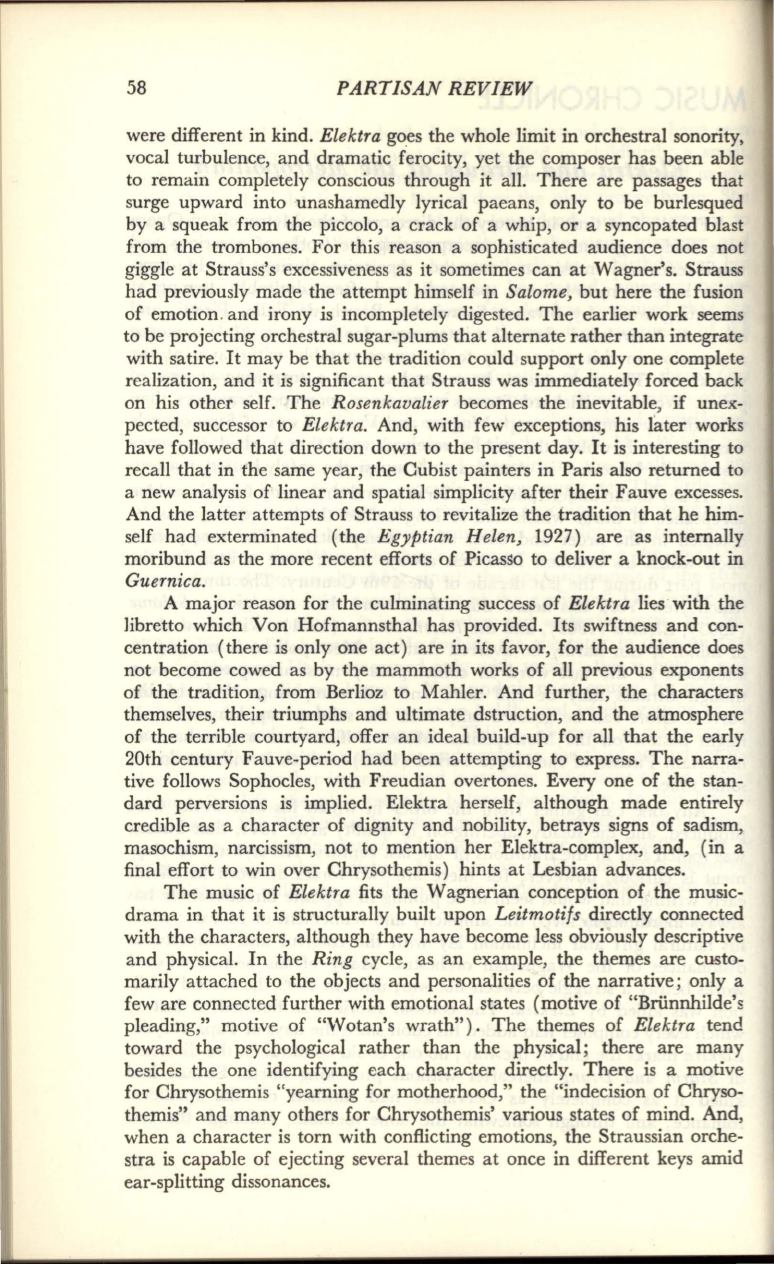
58
PARTISAN REVIEW
were different in kind.
Elektra
goes the whole limit in orchestral sonority,
vocal turbulence, and dramatic ferocity, yet the composer has been able
to remain completely conscious through it all. There are passages that
surge upward into unashamedly lyrical paeans, only to be burlesqued
by a squeak from the piccolo, a crack of a whip, or a syncopated blast
from the trombones. For this reason a sophisticated audience does not
giggle at Strauss's excessiveness as it sometimes can at Wagner's. Strauss
had previously made the attempt himself in
Salome,
but here the fusion
of emotion . and irony is incompletely digested. The earlier work seems
to be projecting orchestral sugar-plums that alternate rather than integrate
with satire. It may be that the tradition could support only one complete
realization, and it is significant that Strauss was immediately forced back
on his other self. The
Rosenkavalier
becomes the inevitable, if unex–
pected, successor to
Elektra.
And, with few exceptions, his later works
have followed that direction down to the present day. It is interesting to
recall that in the same year, the Cubist painters in Paris also returned to
a new analysis of linear and spatial simplicity after their Fauve excesses.
And the latter attempts of Strauss to revitalize the tradition that he him–
self had exterminated (the
Egyptian Helen,
1927) are as internally
moribund as the more recent efforts of Picasso to deliver a knock-out in
Guernica.
A major reason for the culminating success of
Elektra
lies with the
libretto which Von Hofmannsthal has provided. Its swiftness and con–
centration (there is only one act) are in its favor, for the audience does
not become cowed as by the mammoth works of all previous exponents
of the tradition, from Berlioz to Mahler. And further, the characters
themselves, their triumphs and ultimate dstruction, and the atmosphere
of the terrible courtyard, offer an ideal build-up for all that the early
20th century Fauve-period had been attempting to express. The narra–
tive follows Sophocles, with Freudian overtones. Every one of the stan–
dard perversions is implied. Elektra herself, although made entirely
credible as a character of dignity and nobility, betrays signs of sadism,
masochism, narcissism, not to mention her Elektra-complex, and, (in a
final effort to win over Chrysothemis) hints at Lesbian advances.
The music of
Elektra
fits the Wagnerian conception of the music–
drama in that it is structurally built upon
Leitmotifs
directly connected
with the characters, although they have become less obviously descriptive
and physical. In the
Ring
cycle, as an example, the themes are custo–
marily attached to the objects and personalities of the narrative; only a
few are connected further with emotional states (motive of "Briinnhilde's
pleading," motive of "'Wotan's wrath"). The themes of
Elektra
tend
toward the psychological rather than the physical; there are many
besides the one identifying each character directly. There is a motive
for Chrysothemis "yearning for motherhood," the "indecision of Chryso–
themis" and many others for Chrysothemis' various states of mind. And,
when a character is torn with conflicting emotions, the Straussian orche–
stra is capable of ejecting several themes at once in different keys amid
ear-splitting dissonances.


